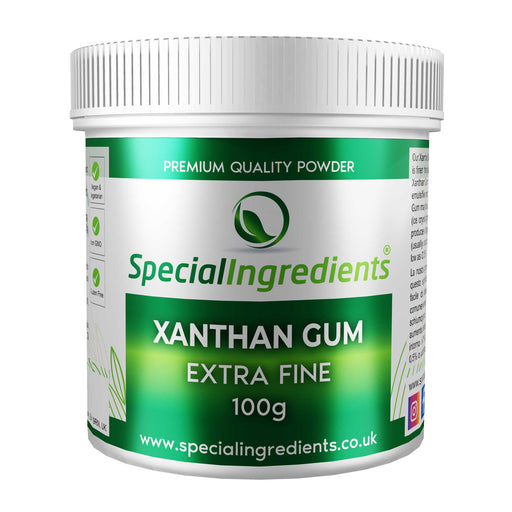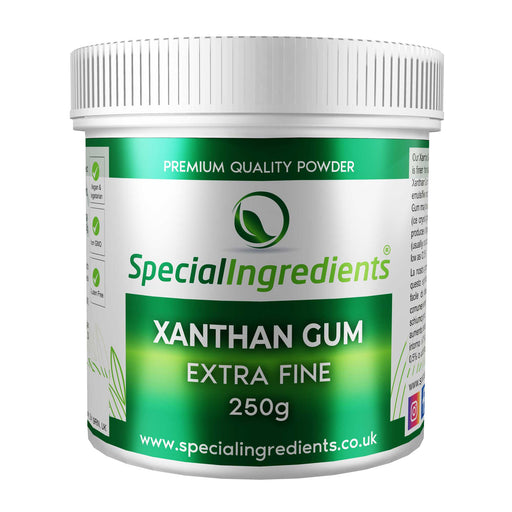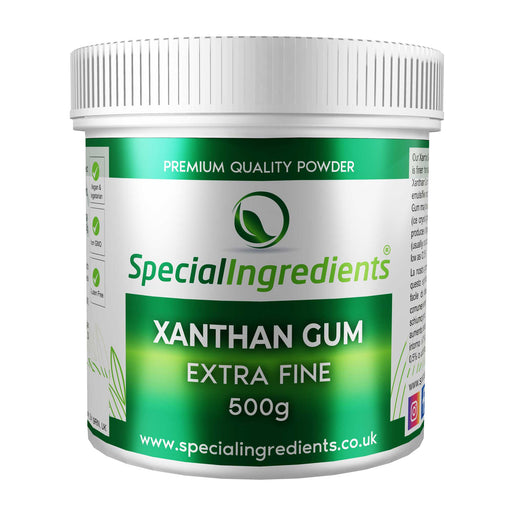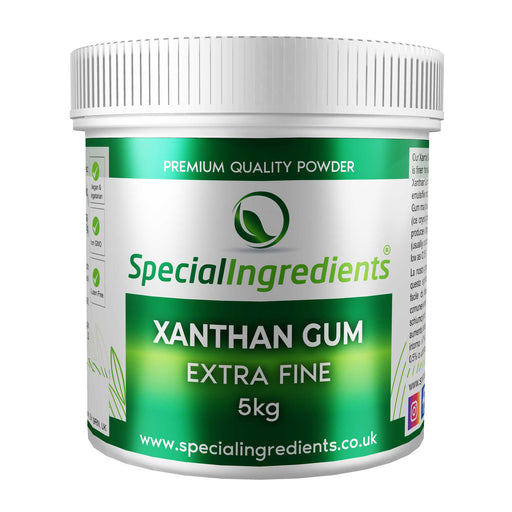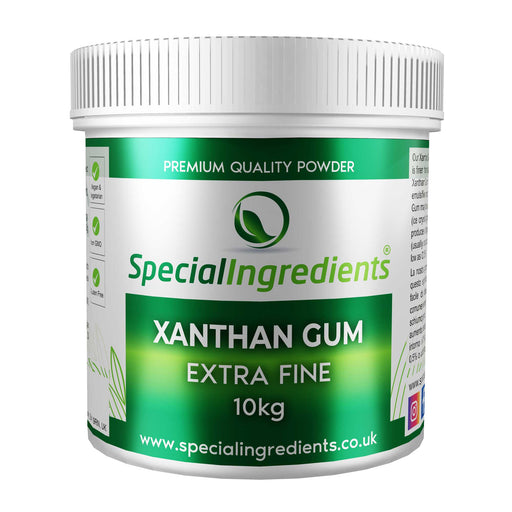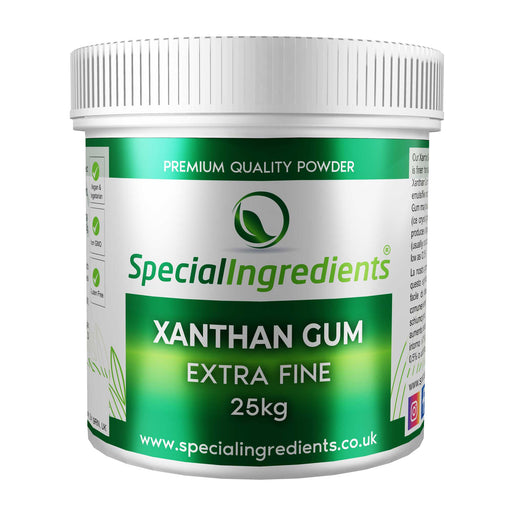Xanthan Gum
Filters
-
Original price €8,95 - Original price €8,95Original price€8,95€8,95 - €8,95Current price €8,95| /
Xanthan Gum 100g
Our Xanthan Gum is 200 mesh compared to the standard 80 mesh, this means it is finer than standard Xanthan Gum making it easier to disperse and dis...
View full detailsOriginal price €8,95 - Original price €8,95Original price€8,95€8,95 - €8,95Current price €8,95| / -
Original price €14,95 - Original price €14,95Original price€14,95€14,95 - €14,95Current price €14,95| /
Xanthan Gum 250g
Our Xanthan Gum is 200 mesh compared to the standard 80 mesh, this means it is finer than standard Xanthan Gum making it easier to disperse and dis...
View full detailsOriginal price €14,95 - Original price €14,95Original price€14,95€14,95 - €14,95Current price €14,95| / -
Original price €19,95 - Original price €19,95Original price€19,95€19,95 - €19,95Current price €19,95| /
Molecular Gastronomy Ingredients Pack (4 x 50g)
Molecular Gastronomy Ingredients Pack - Agar Agar 50g, Calcium Lactate 50g, Sodium Alginate 50g & Xanthan Gum 50g Contents: Agar Agar 50g (...
View full detailsOriginal price €19,95 - Original price €19,95Original price€19,95€19,95 - €19,95Current price €19,95| / -
Original price €22,95 - Original price €22,95Original price€22,95€22,95 - €22,95Current price €22,95| /
Xanthan Gum 500g
Our Xanthan Gum is 200 mesh compared to the standard 80 mesh, this means it is finer than standard Xanthan Gum making it easier to disperse and dis...
View full detailsOriginal price €22,95 - Original price €22,95Original price€22,95€22,95 - €22,95Current price €22,95| / -
Original price €38,95 - Original price €38,95Original price€38,95€38,95 - €38,95Current price €38,95| /
Molecular Gastronomy Ingredients Pack (4 x 100g)
Molecular Gastronomy Ingredients Pack - Agar Agar 100g, Calcium Lactate 100g, Sodium Alginate 100g & Xanthan Gum 100g Contents: Agar Agar 100...
View full detailsOriginal price €38,95 - Original price €38,95Original price€38,95€38,95 - €38,95Current price €38,95| / -
Original price €118,95Original price €118,95 - Original price €118,95Original price €118,95Current price €112,95€112,95 - €112,95Current price €112,95| /
Xanthan Gum 5kg
Our Xanthan Gum is 200 mesh compared to the standard 80 mesh, this means it is finer than standard Xanthan Gum making it easier to disperse and dis...
View full detailsOriginal price €118,95Original price €118,95 - Original price €118,95Original price €118,95Current price €112,95€112,95 - €112,95Current price €112,95| / -
Original price €209,95Original price €209,95 - Original price €209,95Original price €209,95Current price €189,95€189,95 - €189,95Current price €189,95| /
Xanthan Gum 10kg
Our Xanthan Gum is 200 mesh compared to the standard 80 mesh, this means it is finer than standard Xanthan Gum making it easier to disperse and dis...
View full detailsOriginal price €209,95Original price €209,95 - Original price €209,95Original price €209,95Current price €189,95€189,95 - €189,95Current price €189,95| / -
Original price €512,95 - Original price €512,95Original price€512,95€512,95 - €512,95Current price €512,95| /
Xanthan Gum 25kg
Our Xanthan Gum is 200 mesh compared to the standard 80 mesh, this means it is finer than standard Xanthan Gum making it easier to disperse and dis...
View full detailsOriginal price €512,95 - Original price €512,95Original price€512,95€512,95 - €512,95Current price €512,95| /
What is Xanthan Gum?
Xanthan gum is an odourless white powder.
Xanthan gum is a polysaccharide (a type of carbohydrate) that is produced by a type of bacteria called Xanthomonas campestris. The bacteria are grown in a nutrient-rich solution. After the bacteria have fermented the solution, the xanthan gum is then precipitated, dried, and ground into a fine powder.
The process of producing Xanthan gum was first developed by the United States Department of Agriculture in the 1960s, and it has since become a widely used food additive due to its unique properties as a thickener, stabiliser, and emulsifier.
Xanthan gum has recently become more known in in restaurants and kitchens as a molecular gastronomy ingredient as commonly used by world renowned chefs as a magic ingredient to get their desired results.
Xanthan Gum Benefits
When adding Xanthan gum to a liquid it disperses and creates a viscous solution which is stable. Xanthan gum is a fantastic thickener, stabiliser, and emulsifier for many products.
Only a small amount of Xanthan gum is required to stabilise, emulsion, gel or foam.
Gluten Free BakingXanthan gum is becoming a more popular option for gluten free baking. Xanthan gum helps with the binding of certain gluten free ingredients which require additional assistance in the binding process.
Xanthan Gum Uses
Here are some of its main uses of Xanthan gum:
-
Thickening: Xanthan gum is used to increase the viscosity of liquids, making them thicker and more gel-like. It's often used as a thickener in sauces, dressings, and soups, as well as in dairy and non-dairy products.
-
Stabilizing: Xanthan gum helps to prevent ingredients from separating, making it useful in products that require a stable emulsion, such as ice cream, salad dressings, and whipped toppings.
-
Gluten-free baking: Xanthan gum is a popular ingredient in gluten-free baking because it helps to bind and stabilize the dough, providing structure and texture that is often missing in gluten-free baked goods.
- Ice Cream: When adding to ice cream, Xanthan gum slows formation of crystals when the freezing process is in operation, this helps ensure that your ice cream has a creamy and smooth texture in the mouth.
Xanthan gum is typically found in the below food products:
- Xanthan Gum In Baked products
- Xanthan Gum In Ice creams
- Xanthan Gum In Sauces
- Xanthan Gum In Soups
- Xanthan Gum In Syrups
- Xanthan Gum In Gravies
- Xanthan Gum In Gluten free products
Many people search where to buy Xanthan gum, this is because not all Xanthan gum is of the same quality. Special Ingredients ensures that the Xanthan Gum supplied to you for your recipes is of the highest quality. Customers purchase Xanthan gum supplied by Special ingredients from many countries world wide with a customer base consisting of high end blue chip restaurant's and chefs alike.
How to cook with Special Ingredients Xanthan Gum
It is best to use precise high accuracy scales when cooking with xanthan gum as most recipes referencing the use of Xanthan Gum only require a very small and specific amount to achieve the desired results. Special ingredients supply high accuracy scales within our Digital Kitchen Scales category.
Xanthan Gum can produce a large increase in the viscosity of a liquid by adding a small amount (usually around 1%), however, in most applications, it is used at 0.5% or even as low as 0.05%
When adding Xanthan gum to a liquid it disperses and creates a viscous solution which is stable. Xanthan gum is a fantastic thickener, stabiliser, and emulsifier for many products.
Xanthan Gum Alternatives ( Guar Gum )
Special Ingredients also supply several alternatives to Xanthan Gum including Guar Gum:
Guar Gum can be used as an alternative for Xanthan Gum in several recipes as they are both thickening agents and stabilizers that can be used in gluten-free baking. In many recipes the amount of Guar Gum required is similar to Xanthan Gum, however we would recommend you experiment with a small batch first to see if there is any difference in how the alternative affects the recipe.
